diff options
| author | Chris Akritidis <43294513+cakrit@users.noreply.github.com> | 2023-02-25 08:28:28 -0800 |
|---|---|---|
| committer | GitHub <noreply@github.com> | 2023-02-25 08:28:28 -0800 |
| commit | de52f8adef9c12d10a319f85220173dd4de050a1 (patch) | |
| tree | 0addcdb757264f47a5226989207522379040a62d /docs | |
| parent | 7c124972e17f73692e464c529de6be27f7236166 (diff) | |
Reorg information and add titles (#14608)
Diffstat (limited to 'docs')
| -rw-r--r-- | docs/cloud/cheatsheet.md | 13 | ||||
| -rw-r--r-- | docs/cloud/visualize/interact-new-charts.md | 196 | ||||
| -rw-r--r-- | docs/dashboard/interact-charts.md | 201 | ||||
| -rw-r--r-- | docs/getting-started/introduction.md | 11 | ||||
| -rw-r--r-- | docs/quickstart/infrastructure.md | 11 | ||||
| -rw-r--r-- | docs/store/distributed-data-architecture.md | 16 |
6 files changed, 159 insertions, 289 deletions
diff --git a/docs/cloud/cheatsheet.md b/docs/cloud/cheatsheet.md index 72e409a990..531f65f4f2 100644 --- a/docs/cloud/cheatsheet.md +++ b/docs/cloud/cheatsheet.md @@ -1,15 +1,4 @@ -<!-- -title: "Netdata management and configuration cheatsheet" -description: "'Connecting an Agent to the Cloud allows a Netdata Agent, running on a distributed node, to securely connect to Netdata Cloud via the encrypted Agent-Cloud link (ACLK).'" -image: "/cheatsheet/cheatsheet-meta.png" -sidebar_label: "Cheatsheet" -custom_edit_url: "https://github.com/netdata/netdata/blob/master/docs/cloud/cheatsheet.md" -part_of_learn: "True" -learn_status: "Published" -learn_topic_type: "Getting started" -learn_rel_path: "Getting started" -sidebar_position: "100" ---> +# Management and configuration cheatsheet import { OneLineInstallWget, diff --git a/docs/cloud/visualize/interact-new-charts.md b/docs/cloud/visualize/interact-new-charts.md index 53a792191c..891b468d31 100644 --- a/docs/cloud/visualize/interact-new-charts.md +++ b/docs/cloud/visualize/interact-new-charts.md @@ -1,20 +1,4 @@ -<!-- -title: "Interact with charts" -description: >- - "Learn how to get the most out of Netdata's charts. These charts will help you make sense of all the - metrics at your disposal, helping you troubleshoot with real-time, per-second metric data" -type: "how-to" -custom_edit_url: "https://github.com/netdata/netdata/blob/master/docs/cloud/visualize/interact-new-charts.md" -sidebar_label: "Interact with charts" -learn_status: "Published" -learn_topic_type: "Concepts" -learn_rel_path: "Operations/Visualizations" ---> - -> ⚠️ This new version of charts is currently **only** available on Netdata Cloud. We didn't want to keep this valuable -> feature from you, so after we get this into your hands on the Cloud, we will collect and implement your feedback. -> Together, we will be able to provide the best possible version of charts on the Netdata Agent dashboard, as quickly as -> possible. +# Interact with charts Netdata excels in collecting, storing, and organizing metrics in out-of-the-box dashboards. To make sense of all the metrics, Netdata offers an enhanced version of charts that update every second. @@ -33,10 +17,12 @@ These charts provide a lot of useful information, so that you can: - View information about the chart, its plugin, context, and type - Get the chart status and possible errors. On top, reload functionality -These charts will available -on [Overview tab](https://github.com/netdata/netdata/blob/master/docs/cloud/visualize/overview.md), Single Node view and +These charts are available on Netdata Cloud's +[Overview tab](https://github.com/netdata/netdata/blob/master/docs/cloud/visualize/overview.md), Single Node view and on your [Custom Dashboards](https://github.com/netdata/netdata/blob/master/docs/cloud/visualize/dashboards.md). +Some of the features listed below are also available on the simpler charts that are available on each agent's user interface. + ## Overview Have a look at the can see the overall look and feel of the charts for both with a composite chart from @@ -48,14 +34,15 @@ from the single node view: With a quick glance you have immediate information available at your disposal: - Chart title and units +- Definition bar - Action bars - Chart area - Legend with dimensions ## Play, Pause and Reset -Your charts are controlled using the -available [Time controls](https://github.com/netdata/netdata/blob/master/docs/dashboard/visualization-date-and-time-controls.md#time-controls). +Your charts are controlled using the available +[Time controls](https://github.com/netdata/netdata/blob/master/docs/dashboard/visualization-date-and-time-controls.md#time-controls). Besides these, when interacting with the chart you can also activate these controls by: - Hovering over any chart to temporarily pause it - this momentarily switches time control to Pause, so that you can @@ -92,7 +79,148 @@ The elements that you can find on this top bar are:  -### Chart action bar +## Definition bar + +Each composite chart has a definition bar to provide information about the following: + +* Grouping option +* Aggregate function to be applied in case multiple data sources exist +* Instances +* Nodes +* Dimensions, and +* Aggregate function over time to be applied if one point in the chart consists of multiple data points aggregated + +### Group by dimension, node, or chart + +Click on the **dimension** dropdown to change how a composite chart groups metrics. + +The default option is by _dimension_, so that each line/area in the visualization is the aggregation of a single +dimension. +This provides a per dimension view of the data from all the nodes in the War Room, taking into account filtering +criteria if defined. + +A composite chart grouped by _node_ visualizes a single metric across contributing nodes. If the composite chart has +five +contributing nodes, there will be five lines/areas. This is typically an absolute value of the sum of the dimensions +over each node but there +are some opinionated-but-valuable exceptions where a specific dimension is selected. +Grouping by nodes allows you to quickly understand which nodes in your infrastructure are experiencing anomalous +behavior. + +A composite chart grouped by _instance_ visualizes each instance of one software or hardware on a node and displays +these as a separate dimension. By grouping the +`disk.io` chart by _instance_, you can visualize the activity of each disk on each node that contributes to the +composite +chart. + +Another very pertinent example is composite charts over contexts related to cgroups (VMs and containers). You have the +means to change the default group by or apply filtering to +get a better view into what data your are trying to analyze. For example, if you change the group by to _instance_ you +get a view with the data of all the instances (cgroups) that +contribute to that chart. Then you can use further filtering tools to focus the data that is important to you and even +save the result to your own dashboards. + + + +### Aggregate functions over data sources + +Each chart uses an opinionated-but-valuable default aggregate function over the data sources. For example, +the `system.cpu` chart shows the +average for each dimension from every contributing chart, while the `net.net` chart shows the sum for each dimension +from every contributing chart, which can also come from multiple networking interfaces. + +The following aggregate functions are available for each selected dimension: + +- **Average**: Displays the average value from contributing nodes. If a composite chart has 5 nodes with the following + values for the `out` dimension—`-2.1`, `-5.5`, `-10.2`, `-15`, `-0.1`—the composite chart displays a + value of `−6.58`. +- **Sum**: Displays the sum of contributed values. Using the same nodes, dimension, and values as above, the composite + chart displays a metric value of `-32.9`. +- **Min**: Displays a minimum value. For dimensions with positive values, the min is the value closest to zero. For + charts with negative values, the min is the value with the largest magnitude. +- **Max**: Displays a maximum value. For dimensions with positive values, the max is the value with the largest + magnitude. For charts with negative values, the max is the value closet to zero. + +### Dimensions + +Select which dimensions to display on the composite chart. You can choose **All dimensions**, a single dimension, or any +number of dimensions available on that context. + +### Instances + +Click on **X Instances** to display a dropdown of instances and nodes contributing to that composite chart. Each line in +the dropdown displays an instance name and the associated node's hostname. + +### Nodes + +Click on **X Nodes** to display a dropdown of nodes contributing to that composite chart. Each line displays a hostname +to help you identify which nodes contribute to a chart. You can also use this component to filter nodes directly on the +chart. + +If one or more nodes can't contribute to a given chart, the definition bar shows a warning symbol plus the number of +affected nodes, then lists them in the dropdown along with the associated error. Nodes might return errors because of +networking issues, a stopped `netdata` service, or because that node does not have any metrics for that context. + +### Aggregate functions over time + +When the granularity of the data collected is higher than the plotted points on the chart an aggregation function over +time +is applied. By default the aggregation applied is _average_ but the user can choose different options from the +following: + +* Min +* Max +* Average +* Sum +* Incremental sum (Delta) +* Standard deviation +* Median +* Single exponential smoothing +* Double exponential smoothing +* Coefficient variation +* Trimmed Median `*` +* Trimmed Mean `*` +* Percentile `**` + +:::info + +- `*` For **Trimmed Median and Mean** you can choose the percentage of data tha you want to focus on: 1%, 2%, 3%, 5%, + 10%, 15%, 20% and 25%. +- `**` For **Percentile** you can specify the percentile you want to focus on: 25th, 50th, 75th, 80th, 90th, 95th, 97th, + 98th and 99th. + +::: + +For more details on each, you can refer to our Agent's HTTP API details +on [Data Queries - Data Grouping](/docs/agent/web/api/queries#data-grouping). + +### Reset to defaults + +Click on the 3-dot icon (**⋮**) on any chart, then **Reset to Defaults**, to reset the definition bar to its initial +state. + +## Jump to single-node dashboards + +Click on **X Charts**/**X Nodes** to display one of the two dropdowns that list the charts and nodes contributing to a +given composite chart. For example, the nodes dropdown. + +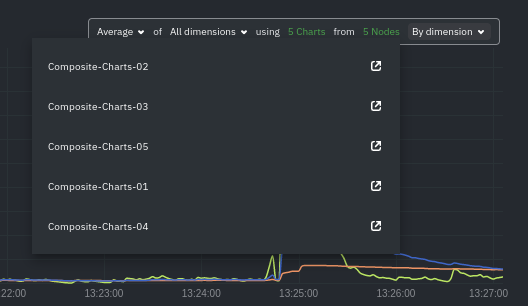 + +To jump to a single-node dashboard, click on the link icon +<img class="img__inline img__inline--link" src="https://user-images.githubusercontent.com/1153921/95762109-1d219300-0c62-11eb-8daa-9ba509a8e71c.png" /> next to the +node you're interested in. + +The single-node dashboard opens in a new tab. From there, you can continue to troubleshoot or run +[Metric Correlations](https://github.com/netdata/netdata/blob/master/docs/cloud/insights/metric-correlations.md) for faster root +cause analysis. + +## Add composite charts to a dashboard + +Click on the 3-dot icon (**⋮**) on any chart, then click on **Add to Dashboard**. Click the **+** button for any +dashboard you'd like to add this composite chart to, or create a new dashboard an initiate it with your chosen chart by +entering the name and clicking **New Dashboard**. + +## Chart action bar On this bar you have access to immediate actions over the chart, the available actions are: @@ -127,24 +255,13 @@ it like pushing the current timeframe off the screen to see what came before or ### Highlight -Selecting timeframes is useful when you see an interesting spike or change in a chart and want to investigate further, -from looking at the same period of time on other charts/sections or triggering actions to help you troubleshoot with an -in-context action bar to help you troubleshoot (currently only available on -Single Node view). The available actions: - -- - -run [Metric Correlations](https://github.com/netdata/netdata/blob/master/docs/cloud/insights/metric-correlations.md) - -- zoom in on the selected timeframe - -[Metric Correlations](https://github.com/netdata/netdata/blob/master/docs/cloud/insights/metric-correlations.md) -will only be available if you respect the timeframe selection limitations. The selected duration pill together with the -button state helps visualize this. +Selecting timeframes is useful when you see an interesting spike or change in a chart and want to investigate further by: -<img src="https://images.zenhubusercontent.com/60b4ebb03f4163193ec31819/2ffc157d-0f0f-402e-80bb-5ffa8a2091d5" width="50%" height="50%" /> +- Looking at the same period of time on other charts/sections +- Running [metric correlations](https://github.com/netdata/netdata/blob/master/docs/cloud/insights/metric-correlations.md) + to filter metrics that also show something different in the selected period, vs the previous one -<p/> +<img alt="image" src="https://user-images.githubusercontent.com/43294513/221365853-1142944a-ace5-484a-a108-a205d050c594.png" /> | Interaction | Keyboard/mouse | Touchpad/touchscreen | |:-----------------------------------|:---------------------------------------------------------|:---------------------| @@ -158,8 +275,7 @@ week, which is useful in understanding what "normal" looks like, or to identify memory usage. The actions above are _normal_ vertical zoom actions. We also provide an horizontal zoom action that helps you focus on -a -specific Y-axis area to further investigate a spike or dive on your charts. +a specific Y-axis area to further investigate a spike or dive on your charts.  diff --git a/docs/dashboard/interact-charts.md b/docs/dashboard/interact-charts.md deleted file mode 100644 index a896b781c0..0000000000 --- a/docs/dashboard/interact-charts.md +++ /dev/null @@ -1,201 +0,0 @@ -<!-- -title: "Interact with charts" -description: "Learn how to pan, zoom, select, and customize Netdata's preconfigured charts to help you troubleshooting with real-time, per-second metrics data." -type: "how-to" -custom_edit_url: "https://github.com/netdata/netdata/edit/master/docs/dashboard/interact-charts.md" -sidebar_label: "Interact with charts" -learn_status: "Published" -learn_topic_type: "Tasks" -learn_rel_path: "Operations" ---> - -# Interact with charts - -> ⚠️ There is a new version of charts that is currently **only** available on [Netdata Cloud](https://github.com/netdata/netdata/blob/master/docs/cloud/visualize/interact-new-charts.md). We didn't -> want to keep this valuable feature from you, so after we get this into your hands on the Cloud, we will collect and implement your feedback to make sure we are providing the best possible version of the feature on the Netdata Agent dashboard as quickly as possible. - -While charts that update every second with new metrics are helpful for understanding the immediate state of a node, deep -troubleshooting and root cause analysis begins by manipulating the default charts. To help you troubleshoot, Netdata -synchronizes every chart every time you interact with one of them. - -Here's what synchronization looks like: - -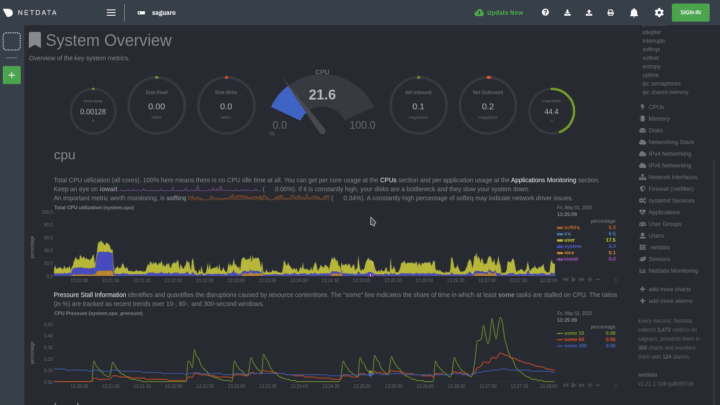 - -Once you understand all the interactions available to you, you'll be able to quickly move around the dashboard, search -for anomalies, and find root causes using per-second metrics. - -## Pause or stop - -| Interaction | Keyboard/mouse | Touchpad/touchscreen | -| :---------------- | :------------- | :------------------- | -| **Pause** a chart | `hover` | `n/a` | -| **Stop** a chart | `click` | `tap` | - -By hovering over any chart, you temporarily pause it so that you can hover over a specific timeframe and see the exact -values presented as dimensions. Click on the chart to lock it to this timeframe, which is useful if you want to jump to -a different chart to look for possible correlations. - -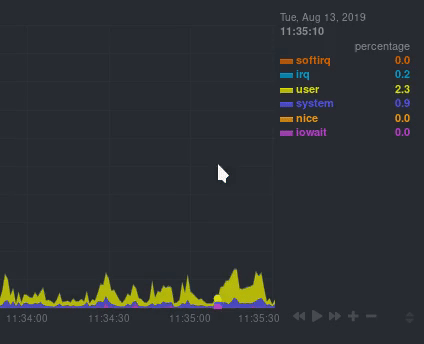 - -## Pan - -| Interaction | Keyboard/mouse | Touchpad/touchscreen | -| :---------- | :------------- | :------------------- | -| **Pan** | `click + drag` | `swipe` | - -Drag your mouse/finger to the right to pan backward through time, or drag to the left to pan forward in time. Think of -it like pushing the current timeframe off the screen to see what came before or after. - -## Zoom - -| Interaction | Keyboard/mouse | Touchpad/touchscreen | -| :------------------------------- | :-------------------------- | :--------------------------------------------------- | -| **Zoom** in or out | `Shift + mouse scrollwheel` | `two-finger pinch` <br />`Shift + two-finger scroll` | -| **Zoom** to a specific timeframe | `Shift + mouse selection` | `n/a` | - -Zooming in helps you see metrics with maximum granularity, which is useful when you're trying to diagnose the root cause -of an anomaly or outage. Zooming out lets you see metrics within the larger context, such as the last hour, day, or -week, which is useful in understanding what "normal" looks like, or to identify long-term trends, like a slow creep in -memory usage. - -## Select - -| Interaction | Keyboard/mouse | Touchpad/touchscreen | -| :------------------------------ | :-------------------------------------------------------- | :------------------- | -| **Select** a specific timeframe | `Alt + mouse selection` or `⌘ + mouse selection` (macOS) | `n/a` | - -Selecting timeframes is useful when you see an interesting spike or change in a chart and want to investigate further. - -Select a timeframe, then move to different charts/sections of the dashboard. Each chart shows the same selection to help -you immediately identify the timeframe and look for correlations. - -## Reset a chart to its default state - -| Interaction | Keyboard/mouse | Touchpad/touchscreen | -| :---------------- | :------------- | :------------------- | -| **Reset** a chart | `double-click` | `n/a` | - -Double-check on a chart to restore it to the default auto-updating state, with a timeframe based on your browser -viewport. - -## Resize - -Click-and-drag the icon on the bottom-right corner of any chart. To restore the chart to its original height, -double-click the same icon. - -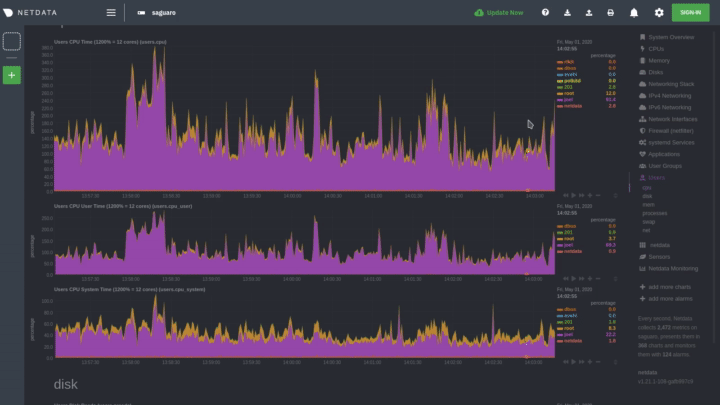 - -## Show and hide dimensions - -| Interaction | Keyboard/mouse | Touchpad/touchscreen | -| :------------------------------------- | :-------------- | :------------------- | -| **Show one** dimension and hide others | `click` | `tap` | -| **Toggle (show/hide)** one dimension | `Shift + click` | `n/a` | - -Hiding dimensions simplifies the chart and can help you better discover exactly which aspect of your system might be -behaving strangely. - -## See the context - -Hover your mouse over the date that appears just beneath the chart itself. A tooltip will tell you the context for that -chart. Below, the context is `apps.cpu`. - -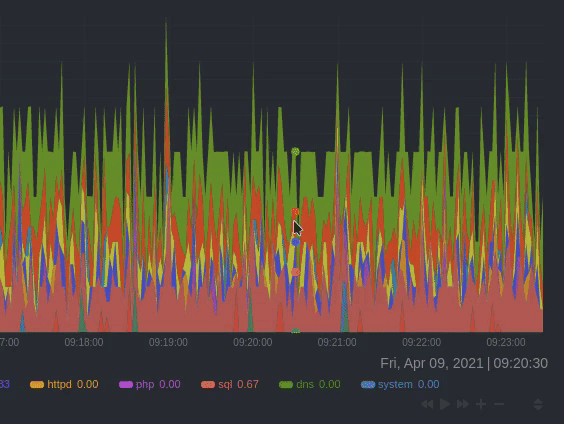 - -## See the resolution and update frequency - -Hover your mouse over the timestamp just to the right of the date. `resolution` is the number of seconds between each -"tick" in the chart. `collection every` is how often Netdata collects and stores that metric. - -If the `resolution` value is higher than `collection every`, such as `resolution 5 secs, collected every 1 sec`, this -means that each tick is calculating represents the average values across a 5-second period. You can zoom in to increase -the resolution to `resolution 1 sec` to see the exact values. - -## Chart controls - -Many of the above interactions can also be triggered using the icons on the bottom-right corner of every chart. They -are, respectively, `Pan Left`, `Reset`, `Pan Right`, `Zoom In`, and `Zoom Out`. - -## Chart label filtering - -The chart label filtering feature supports grouping by and filtering each chart based on labels (key/value pairs) applicable to the context and provides fine-grain capability on slicing the data and metrics. - -All metrics collected get "tagged" with labels and values, thus providing a powerful way of slicing and visualizing all metrics related to the infrastructure. - -The chart label filtering is currently enabled on: - -- All charts on the **Overview** tab -- Custom dashboards - -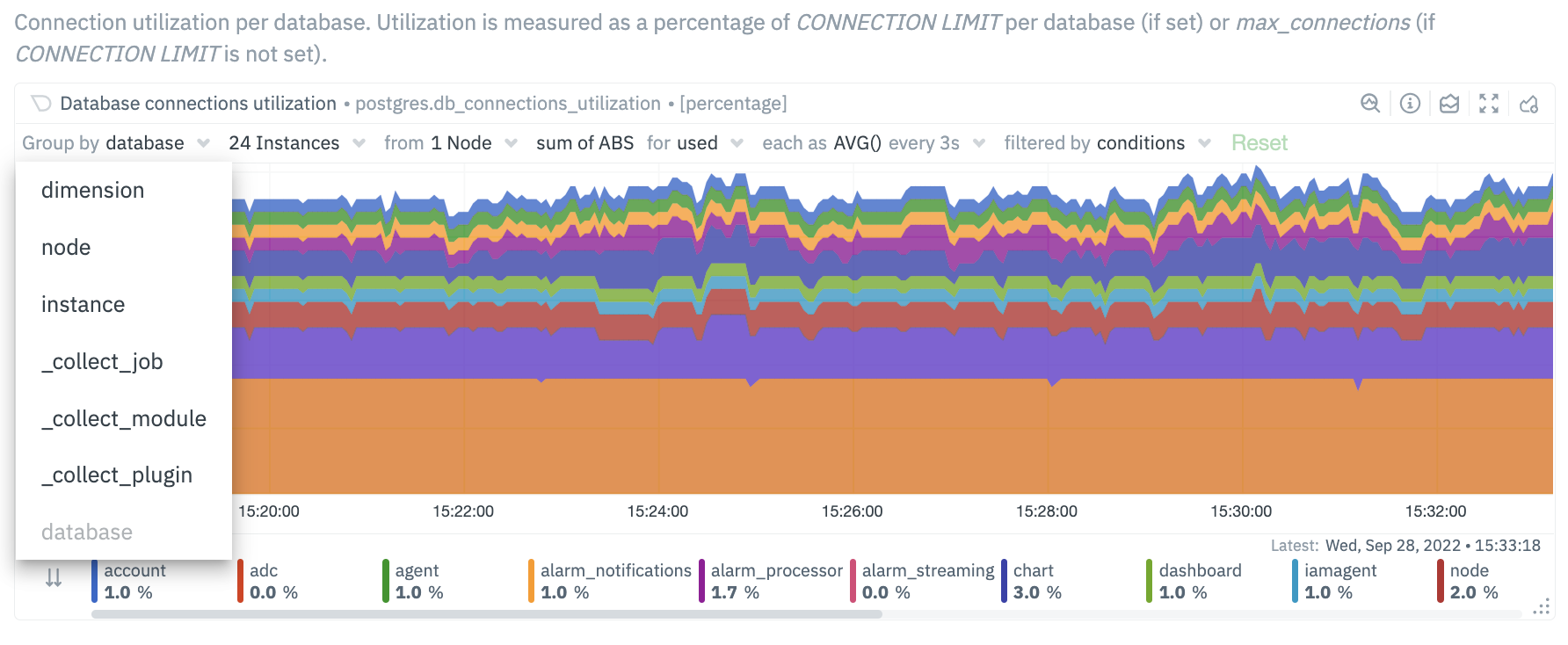 -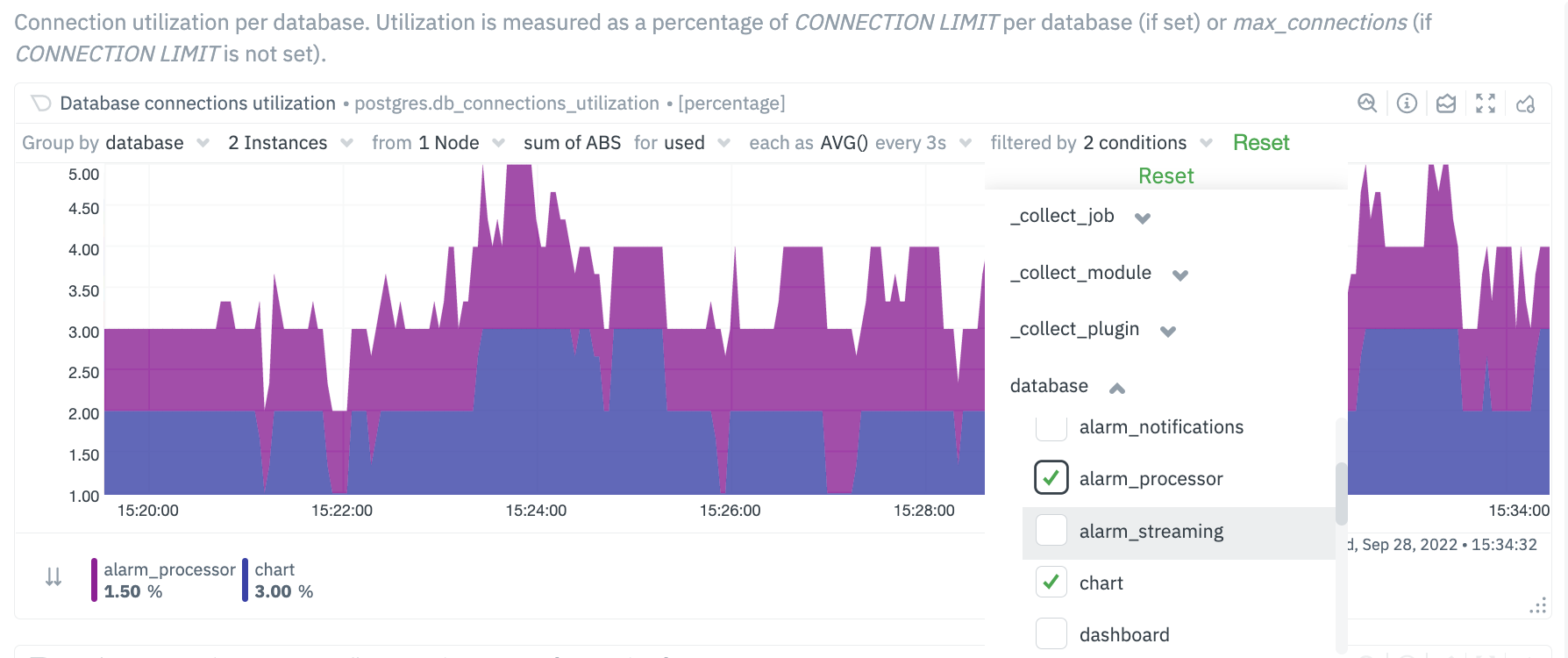 - -The top panel on each chart displays the various filters and grouping options selected on the specific chart. These filters are specific for each chart and need to be manually configured on each chart. - -Additionally, the charts can be saved to a custom dashboard, new or existing, with the selected filters from the overview screen. - -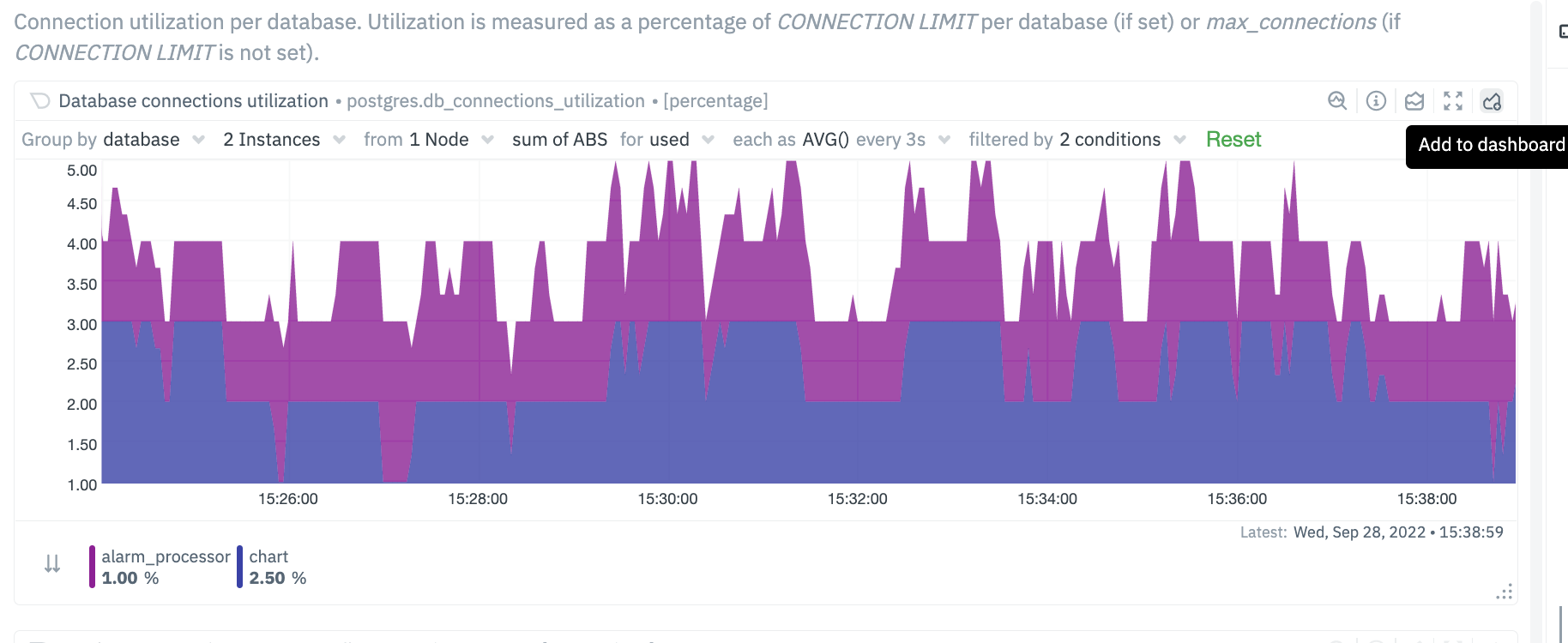 - -## Custom labels for Collectors - -In addition to the default labels associated with a collector and metrics context (you can identify them by seeing which ones have an underscore as a prefix), there is now a new feature enabled to create custom labels. These custom labels may be needed to group your jobs or instances into various categories. - -These custom labels can be configured within your go.d plugins by simply associating a label key/value pair, as in the following eaxmple. - -```conf -jobs: - - name: example_1 - someOption: someValue - labels: - label1: value1 - label2: value2 - - name: example_2 - someOption: someValue - labels: - label3: value3 - label4: value4 -``` - -For instance, you may be running multiple Postgres database instances within an infrastructure. Some of these may be associated with testing environments, some with staging and some with production environments. You can now associate each Postgres job / instance with a custom label. The “group by” and filtering options will then allow you to associate individual jobs by specific labels. - -```conf -jobs: - - name: local - dsn: 'postgres://postgres:postgres@127.0.0.1:5432/postgres' - collect_databases_matching: '*' - labels: - instance_type: production - ``` - 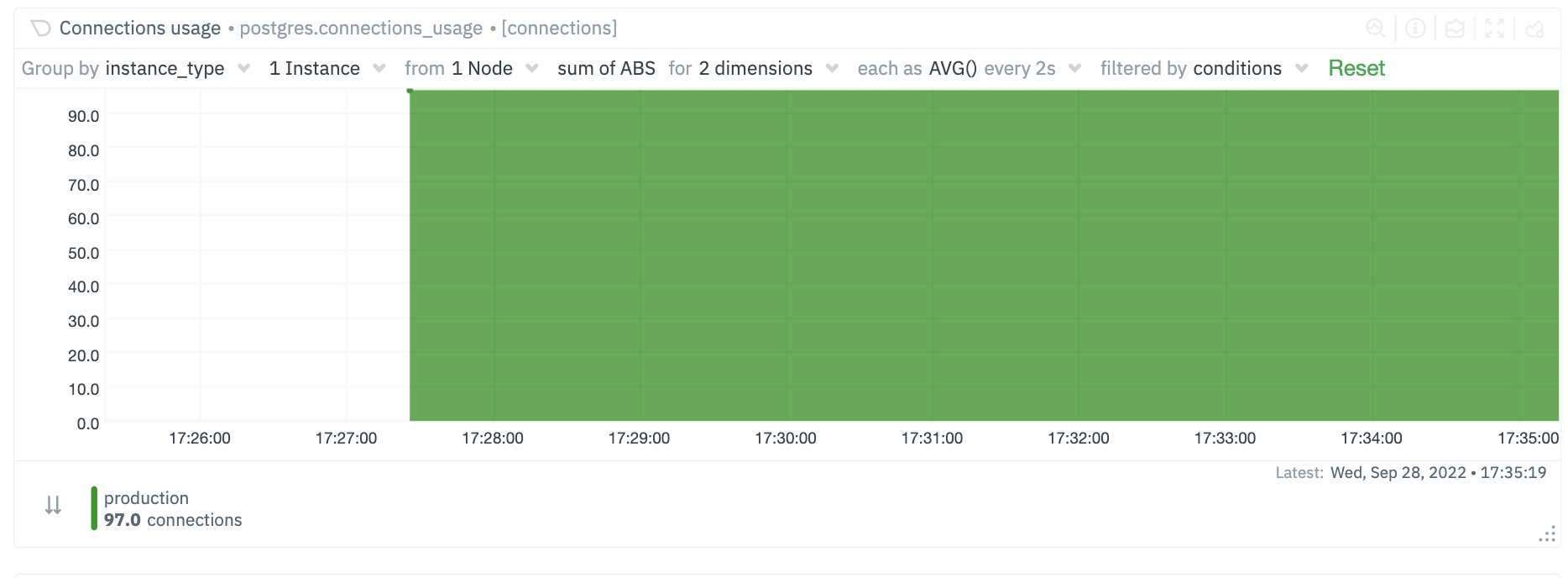 - 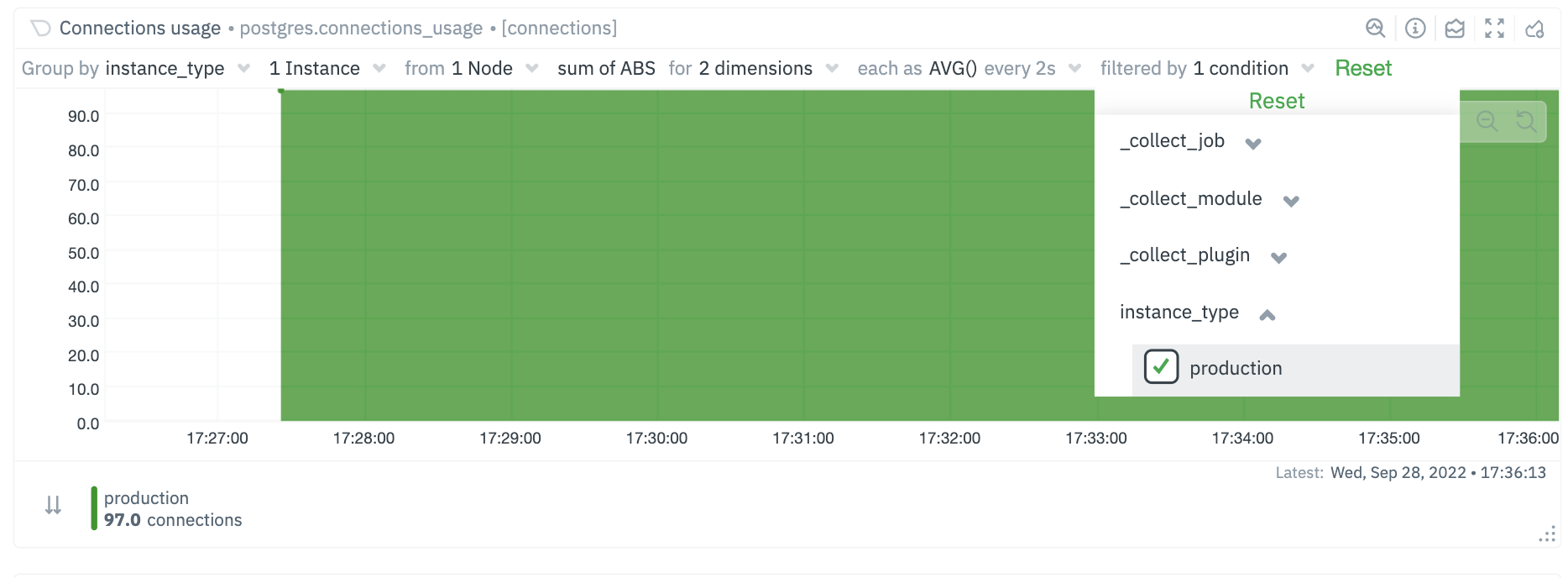 - -### Future Work - -We already have [configurable host labels](https://github.com/netdata/netdata/blob/master/docs/guides/using-host-labels.md) as well, which currently can’t be used to filter or group your metrics. We intend to provide the same capabilities described here with host labels, among other capabilities on other areas of the app as well - -## What's next? - -We recommend you read up on the differences between [chart dimensions, contexts, and -families](https://github.com/netdata/netdata/blob/master/docs/dashboard/dimensions-contexts-families.md) to complete your understanding of how Netdata organizes its -dashboards. Another valuable way to interact with charts is to use the [timeframe -selector](https://github.com/netdata/netdata/blob/master/docs/dashboard/visualization-date-and-time-controls.md), which helps you visualize specific moments of historical metrics. - -If you feel comfortable with the [dashboard](https://github.com/netdata/netdata/blob/master/docs/dashboard/how-dashboard-works.md) and interacting with charts, we -recommend moving on to learning about [configuration](https://github.com/netdata/netdata/blob/master/docs/configure/nodes.md). While Netdata doesn't _require_ a -complicated setup process or a query language to create charts, there are a lot of ways to tweak the experience to match -your needs. - -### Further reading & related information - -- Dashboard - - [How the dashboard works](https://github.com/netdata/netdata/blob/master/docs/dashboard/how-dashboard-works.md) - - [Netdata Cloud · Interact with new charts](https://github.com/netdata/netdata/blob/master/docs/cloud/visualize/interact-new-charts.md) - - [Chart dimensions, contexts, and families](https://github.com/netdata/netdata/blob/master/docs/dashboard/dimensions-contexts-families.md) - - [Select timeframes to visualize](https://github.com/netdata/netdata/blob/master/docs/dashboard/visualization-date-and-time-controls.md) - - [Import, export, and print a snapshot](https://github.com/netdata/netdata/blob/master/docs/dashboard/import-export-print-snapshot.md) - - [Customize the standard dashboard](https://github.com/netdata/netdata/blob/master/docs/dashboard/customize.md) diff --git a/docs/getting-started/introduction.md b/docs/getting-started/introduction.md index ff4be9b1d2..83139252f0 100644 --- a/docs/getting-started/introduction.md +++ b/docs/getting-started/introduction.md @@ -1,13 +1,4 @@ -<!-- -title: "Introduction" -sidebar_label: "Getting Started" -custom_edit_url: "https://github.com/netdata/netdata/blob/master/docs/getting-started/introduction.md" -learn_status: "Published" -sidebar_position: "1" -learn_topic_type: "Getting started" -learn_rel_path: "Getting started" -learn_docs_purpose: "Present netdata in a nutshell" ---> +# Getting started ## What is Netdata ? diff --git a/docs/quickstart/infrastructure.md b/docs/quickstart/infrastructure.md index 92c3cb1a13..23c27e4d08 100644 --- a/docs/quickstart/infrastructure.md +++ b/docs/quickstart/infrastructure.md @@ -1,13 +1,4 @@ -<!-- -title: "Monitor your infrastructure" -description: "Real-time infrastructure monitoring with Netdata Cloud. View key metrics, insightful charts, and active alarms from all your nodes." -custom_edit_url: "https://github.com/netdata/netdata/blob/master/docs/quickstart/infrastructure.md" -sidebar_label: "Monitor your infrastructure" -learn_status: "Published" -learn_topic_type: "Concepts" -learn_rel_path: "Getting Started" -sidebar_position: "50" ---> +# Monitor your infrastructure import { Grid, Box, BoxList, BoxListItemRegexLink } from '@site/src/components/Grid/' import { RiExternalLinkLine } from 'react-icons/ri' diff --git a/docs/store/distributed-data-architecture.md b/docs/store/distributed-data-architecture.md index f4d520ea2e..fffedd8ce8 100644 --- a/docs/store/distributed-data-architecture.md +++ b/docs/store/distributed-data-architecture.md @@ -1,13 +1,3 @@ -<!-- -title: "Distributed data architecture" -description: "Netdata's distributed data architecture stores metrics on individual nodes for high performance and scalability using all your granular metrics." -custom_edit_url: "https://github.com/netdata/netdata/edit/master/docs/store/distributed-data-architecture.md" -sidebar_label: "Distributed data architecture" -learn_status: "Published" -learn_topic_type: "Concepts" -learn_rel_path: "Concepts" ---> - # Distributed data architecture Netdata uses a distributed data architecture to help you collect and store per-second metrics from any number of nodes. @@ -82,11 +72,5 @@ store configured alarms, their status, and a list of active collectors. Netdata does not and never will sell your personal data or data about your deployment. -## What's next? - -You can configure the Netdata Agent to store days, weeks, or months worth of distributed, per-second data by -[configuring the database engine](https://github.com/netdata/netdata/blob/master/docs/store/change-metrics-storage.md). Use our calculator to determine the system -resources required to retain your desired amount of metrics, and expand or contract the database by editing a single -setting. |
